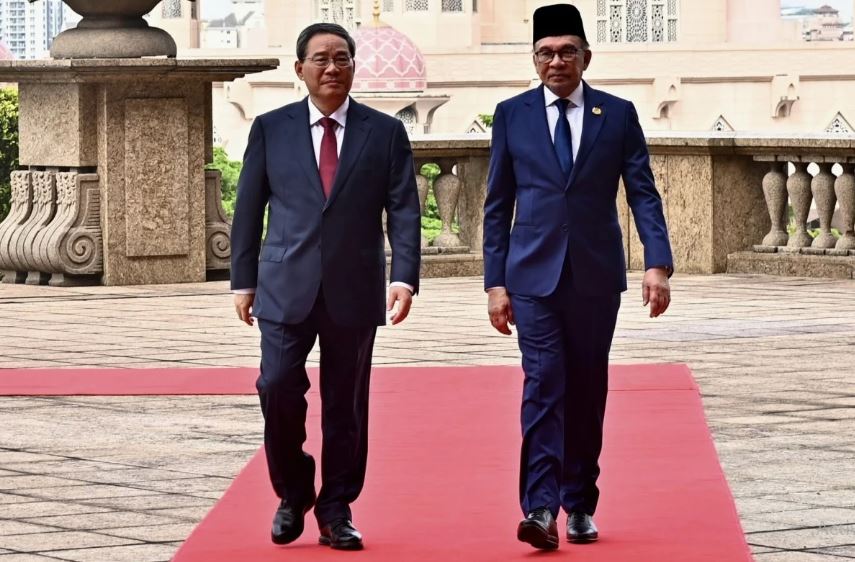
Contrary to the fears of some observers, Malaysia is perfectly capable of securing its interests without choosing one side over another
Malaysian Prime Minister Anwar Ibrahim has found himself having to articulate his government’s relationship with China a great deal lately.
Like his predecessors, he has had to do this frequently since taking power as geopolitical watchers scrutinise Putrajaya’s ties to Beijing with every high-level meeting, public announcement and policy decision. Chinese Premier Li Qiang’s official visit to Malaysia last month to mark the 50th anniversary of diplomatic relations animated the latest round of scrutiny.
Those inclined to place Malaysia in China’s camp might point to the language of Taiwan in the joint statement released by both governments at the end of Li’s visit. Malaysia’s declaration of its recognition of Taiwan as an “inalienable territory of the People’s Republic of China, in order for China to achieve national reunification” and pledge to “not support any call for the independence of Taiwan” stood out as uncharacteristically explicit, particularly when compared to previous joint statements.
In 2016, Malaysian prime minister Najib Razak met Chinese President Xi Jinping as bilateral relations were professed to be at their “highest level” since the establishment of formal ties in 1974. The joint statement released by both governments simply reiterated Malaysia’s “firm adherence to the one China policy” and support for the “peaceful development of cross-Straits relations and China’s peaceful reunification”.
Mahathir Mohamad – whom China has called an “old and good friend” but appeared more critical of the nature and direction of bilateral ties in his return to power – visited China when he was prime minister in 2018. The joint statement afterwards pithily noted that, “Malaysia reiterated its commitment to the One China Policy.”
Putrajaya’s more verbose position in 2024 brought a concerned response from Taipei, which not only condemned and refuted what it said were the “false claims” about Taiwan in the joint statement but also called on the “Malaysian government not to follow China in undermining Taiwan’s sovereignty”. This reaction was perhaps inevitable, given souring ties between Taipei and Beijing as well as what now seems to be a deliberate effort by Beijing to create international support for what it refers to as its one-China principle.
Other background developments have also contributed to perceptions of Malaysia’s growing closeness to China. The Philippines’ defiance in the face of Chinese belligerence in the South China Sea sharply contrasts with Malaysia’s more muted approach. Additionally, expectations that Anwar would lean towards the United States given his strong personal ties to Washington solidified during his years of political persecution appear to be wide of the mark.
It should be clear that viewing Malaysia’s conduct of its foreign relations through a geopolitical filter results in analytical astigmatism. Foreign policy is ultimately an extension of domestic policy, and in a charged climate of strategic competition it is worth disaggregating facts from their optics.
As jarring as Malaysia’s recent affirmation of the status of Taiwan might seem, it was a restatement of language in the 1974 joint communique on the normalisation of relations between China and Malaysia. Paragraph 3 “acknowledges the position of the Chinese Government that Taiwan is an inalienable part of the territory of the People’s Republic of China”. Putrajaya’s 2024 joint statement, therefore, reflects a continuation of Malaysia’s one-China policy from half a century ago.
The wisdom of making such a public display of this position at an internationally delicate time might be arguable given the resulting fallout. Viewed more narrowly through a bilateral lens, however, the move signalled the Anwar government’s extension of goodwill on a matter important to China at a symbolically significant juncture in the relationship without any substantive change or concession in Malaysian policy.
This could also set the tone for both sides to launch a bilateral dialogue on managing maritime issues, which was mentioned in the 2024 joint communique. This plan might come across as wildly naive given the recent turn of events at the Second Thomas Shoal despite the availability of a bilateral consultation mechanism between Beijing and Manila.
Even so, the clashes at sea underscore the urgency of an institutionalised bilateral channel for maritime discussions between Malaysia and China. Having a platform is better than not having one at all, particularly if it can complement ongoing multilateral efforts such as the negotiations over a code of conduct in the South China Sea.
Anwar’s announcement of Malaysia’s intention to join the expanded Brics grouping ahead of Li’s visit provided more fodder for speculation about China’s gravitational pull. To view Malaysia’s interest in this reductive manner, however, is to fundamentally misunderstand the country’s long-standing investment in multilateralism as well as its interest in engaging multiple instruments for different reasons.
Remember that Malaysia negotiated its participation in the Regional Comprehensive Economic Partnership (RCEP) alongside the Trans-Pacific Partnership (TPP). It ratified both RCEP and the TPP’s successor, the Comprehensive and Progressive Agreement for Trans-Pacific Partnership, in the same year.
Similarly, Malaysia’s application for Brics membership will take place as it continues engaging in the Indo-Pacific Economic Framework. It will also assume chairmanship of the Association of Southeast Asian Nations next year while pursuing diplomatic, security and military cooperation in various configurations with a wide range of partners.
At a time when the status quo no longer adequately reflects the desires of the global majority, it only makes sense for Malaysia to seek a more active role in different forums to secure its interests. Contrary to what some might believe, it is possible to walk and chew gum at the same time.
Source: South China Morning Post
Share: